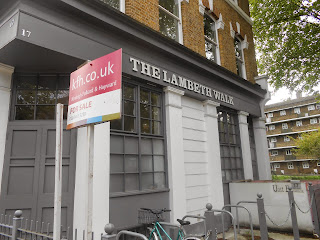I actually have personal memories of China Walk going back to the late 1960s. An old school friend of my father lived there, and we visited on a weekend now and then. I remember playing outside football with the local lads, in exactly the place where I took this photo yesterday. In those days, people actually socialised with their neighbours, and would sit outside chatting endlessly. I remember the shouts of "Oi, keep that bloody ball away from my windows or I'll 'ave yer..!" But I especially remember the corner shop where the lady who ran it made delicious ice lollies from fresh orange juice - the shop is gone, it is now the 'Latinos Help Centre'.
The China Walk Estate is a style of architecture that is very common in South London, especially the in the boroughs that lay on the south bank of the Thames, Lambeth and Southwark especially. In the latter case, much of what was 'Jacob's Island', as immortalised by Charles Dickens in 'Oliver' looks pretty much like this. (Its true - Jacob's Island really did exist. In fact, my daughter's first primary school was on George Row, the easternmost border of Jacob's Island - Now she studies law in the Netherlands).
Yesterday I passed through China Walk and took time to reflect, and to take a few photos. Its not the same now.
To be frank, I only saw a handful of people that I could identify as being indigenous Londoners. They were all very old, and looked stressed and in ill health. Interestingly, I think that all but one that I saw were using walking sticks.
Demographics change, its a fact, and that is not always a negative thing. Much of the old community has done well, and moved on. They simply left the old days behind.
Karel Reisz's classic documentary 'We Are The Lambeth Boys' (1958) was largely filmed in this neighbourhood, and a little to the south heading down to the Oval cricket ground. The follow-up 'We Were The Lambeth Boys' (1985) is of more interest to those who want to see the story of the changes in the community put into a fuller perspective. It also includes most of the more interesting and entertaining content of Reisz's original.



